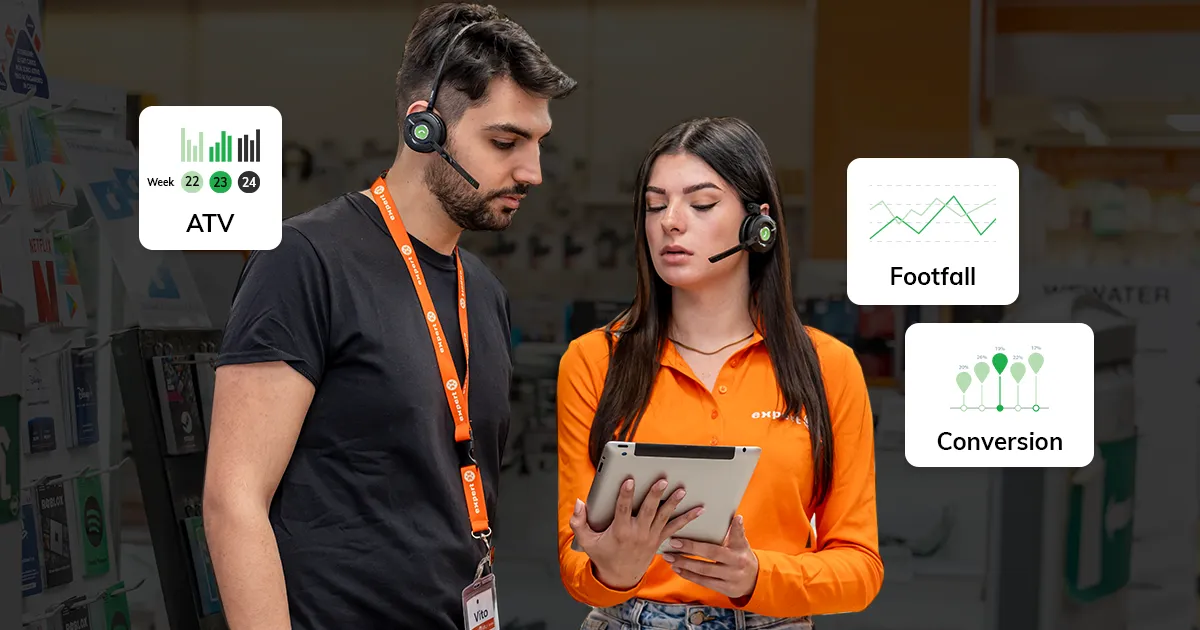
Retail metrics: How in‑store communications can improve 5 key metrics
Running a profitable store takes hard work and a commitment to constant improvement. Which means that on top of the juggling act that is daily store operations, you need to not only track important retail metrics but find new ways to boost them. Which, as we all know, is easier said than done.
But never fear! With the right mindset and an in‑store communication system by your side, hitting your KPIs is easier than ever. So let’s dive into five core retail performance indicators, review why they matter and how in‑store communications technology is key to transforming your store.
Sales per square foot (SPFS)
Let’s start with Sales per square foot. One of the foundational retail performance indicators, it measures how effectively you use your physical space to drive revenue. To get the figure, divide the total net sales by the area of the sales floor.
Total net sales/sales floor area = SPFS
Why is it important?
With this number, you can:
- Evaluate your store design and layout
- Decide on the optimal position for product displays
- More accurately compare performance across different locations
A low SPSF rate often indicates poor merchandising, low foot traffic or underutilization. The good news is that to improve it, you don’t always need to redesign the store — you just need to be more efficient with the space you’ve got.
Optimizing your shop floor
Often, the first step to using your space more efficiently is to walk the floor and see if you can see any issues. Are there gaps? Prices missing? Hero products tucked away? Once you’ve identified any problems, you need to take action, and the speed of your reaction depends on how quickly you can inform and mobilize your team. Huddles and face‑to‑face or written handovers are one way, but they miss out on sharing information at a crucial part of the day — the middle of a shift. Here, retail headsets can speed up communication by allowing you to speak directly to an associate or the entire team, saving you precious time.
And depending on the retail communication system, you don’t need to pick up an in‑store headset to join a team broadcast. You can dial in, join via a smartphone app or even just push a message to multiple store broadcasts at once, making it easy to inform staff of a product recall or other time-sensitive change.
Of course, sometimes when we’re too used to store layouts, we can miss the problems. That’s why the second step you should take is to track frequently asked questions.
By tracking common customer and employee questions, you can quickly see if there are any patterns and discover issues with any number of things, such as signage, location or stock availability. Once these problems are dealt with, sales can increase without constant intervention from sales associates.
While you can track frequently asked questions manually by having a notepad or shared document that associates can update, a quicker and more reliable way is to gather that information automatically through AI. Here, once again, a modern retail communication system can help. For example, a comprehensive retail communication solution equipped with analytics and AI can provide insights from smart call points and even transcriptions and trend reports of what’s being said over the broadcast, highlighting problematic areas of the store and staff training needs. Because while clear signage and beautiful displays are powerful ways to sell products, friendly and knowledgeable associates are also invaluable for helping you maximize sales on the shop floor.
Conversion rate
Without losing our focus on in‑store sales, let’s move to the conversion rate. Your conversion rate measures how many visitors to your store become paying customers.
It is calculated by dividing the number of purchases by the total number of visitors, multiplied by 100. For example, if 100 people visit your store and 25 buy something, the conversion rate is 25%.
Number of receipts/total number of visitors x 100 = conversion rate
Annoyingly, while it’s easy to track online retail performance metrics with a single click and figure out where drop‑offs happen, brick-and-mortar stores don’t get the same level of detail from combining their footfall and POS (point of sale) data to track this metric.
But with different formats come different solutions. So to move this metric in‑store, you can’t always rely on automation. You need something else — empowered store associates.
The role of associates
Let’s face it — store associates have the power to make or break sales. Customers who are unfamiliar with the store layout, have questions on product features or just need some guidance will base their purchase decisions on the quality of their staff interactions.
For example, if a customer asks if an induction stove can be wired in or needs to be plugged into the wall, they expect an answer there and then. If the associate has to leave the customer’s side to consult a colleague or a computer terminal, the customer may lose patience and choose to abandon the purchase.
But if that same employee has access to a hands-free communication system, they can easily ask for colleague support or, if the system is equipped with AI, even speak to an AI assistant. This ensures that the employee never has to leave the customer’s side, keeping the customer engaged and more likely to buy.
And not only that — they’re likely to keep coming back for more.
Average transaction value (ATV)
Now, as you likely know, conversion only tells part of the story. Having high conversion but small ticket purchases still leaves you with low overall sales. Which is why you need to also keep an eye on your basket size or average transaction value (ATV).
How do you calculate it?
By dividing the total number of sales by the total number of transactions.
Total number of sales/total number of transitions = ATV
What does it mean?
Low ATV is often a sign that your store is missing opportunities and should explore ways to increase up‑selling, cross-selling and impulse buying. Even little purchases, if there are enough of them, add up.
The importance of location and advice
The first step a store should take to improve their ATV mechanically is to make sure that add‑on products are placed next to the main product to encourage customers to pick them up. It is also helpful to put higher-margin products closer to customers’ eye level to make them more accessible than inexpensive ones. But for complex purchases, connecting staff can make the biggest difference.
With the ability to instantly speak to colleagues, managers or an AI assistant, associates can instantly access product information and can feel more confident approaching and advising customers.
For example, if a connected associate hears over a headset that a promotion on moisture-wicking socks just went live and then speaks to a customer interested in athletic shoes, they can naturally suggest the socks on the spot, boosting customer satisfaction and sales.
But it’s not just about sharing general messages; with a hands-free communication solution, managers can also coach individuals in real-time. They can jump onto the channel and share a pitch or tactic with the entire team or, depending on the system, individuals, giving managers a powerful tool to manage their team and hit their sales goals.
Customer retention rate
Acquiring a new customer can cost up to five times more than keeping an existing one. As a result, retention is one of the retail industry performance metrics retailers can’t ignore, as it’s a cost-effective way to promote long-term growth.
To find it, you just take the total number of returning customers divided by the total number of customers and multiply it by 100.
Number of returning customers/total number of customers x 100 = customer retention rate
Of course, unlike online shops, it’s not always easy to connect a purchase to a specific customers, which is why this metric relies heavily on a healthy and active loyalty scheme. Still, the retention rate is not just a measure of the strength of your loyalty program but also a reflection of the quality of your brand experience. Because if shoppers don’t feel understood, valued or served well, they’ll vote with their feet.
Tackling wait times
Since we have already tackled the importance of having well-trained and connected employees, the other factor that can greatly impact the customer retention rate is wait times. Ensuring customers enjoy fast, quality service goes a long way in securing short-term and long-term sales.
With a communication system that’s open to integrations, you can send notifications from self-checkout machines, cameras and call points to the store broadcast, ensuring that even employees in the stockroom can quickly respond to waiting customers. For example, you could have a computer-vision-equipped camera automatically notify staff that a customer is waiting or actively looking for help. Automated notifications like these can go a long way to ensuring customers are served promptly at all times, no matter who is staffing the store.
Foot traffic
Vital to one of our earlier metrics, conversion rate, foot traffic is the pulse of your store. It tells you how many people have come in and when, giving you valuable insight into peak trading times at particular stores. Most stores gather it from cameras focused on the entrances and exits and can be analyzed by the hour, day, week, month or even year.
Retailers can use traffic patterns to:
- Optimize store hours and staff schedules
- Plan promos and events
For example, if a store sees a drop in foot traffic on game days and it’s situated near a stadium, tracking that number can help justify scheduling less staff on those days — especially if it’s the only store that experiences the phenomenon.
But what can you do if you detect a spike in foot traffic on the day?
Reacting to surprise traffic
If an unexpected surge in customers hits when you least expect it, an in‑store communication system can help managers quickly redeploy the team to where they’re needed most. This could mean pulling staff from the back office to cover checkouts or even asking restockers to prioritize a particular product or display.
The adaptability of this approach means that foot traffic can be transformed from a passive to an active metric that contributes to growth.
Metrics matter, but action matters more
Tracking different key performance indicators for retail industry growth is not just about reporting — it is also a way for retailers to quickly make decisions based on actionable information. The five metrics we covered are just a taste of how proper data analysis can give you visibility into the inner workings of your store and its daily performance.
So, now that you know what to track, what are retail KPIs going to do for your store? How will you go from monitoring numbers to taking action?
However you decide to do it, you’ll need to mobilize your team and the most effective way to do that is through a modern retail communication solution, like x‑hoppers.
The complete in‑store communication system with AI assistance, x‑hoppers does more than connect your team with push-to-talk headsets; it supports associates’ product knowledge with an AI assistant, helps them react quicker to customers through system integrations and pinpoints weak areas through comprehensive analytics, helping you to reach your targets while also creating an outstanding in‑store experience.
And isn’t that the goal?
Because without action, data is just noise.
Enjoyed this article and want to dive deeper? Find more tips on improving in‑store conversions here or speak to a member of our team to discover how x‑hoppers can help you boost your unique KPIs.



